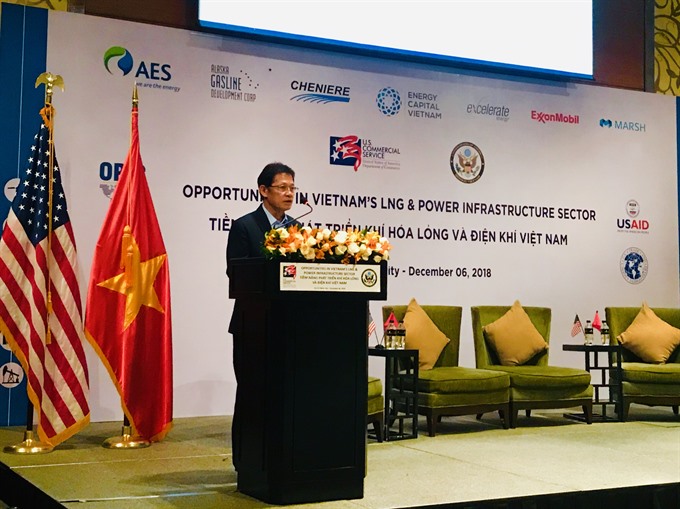 Economy
Economy

The US Government has committed to improving Việt Nam’s energy security status by providing smart, clean technology and developing the liquefied natural gas (LNG) power industry.
 |
| Lê Văn Lực, deputy director of Electricity and Renewable Energy Authority under the Ministry of Industry and Trade, speaks at an Energy Industry Workshop held yesterday in HCM City. — VNS Photo Bồ Xuân Hiệp |
HCM CITY — The US Government has committed to improving Việt Nam’s energy security status by providing smart, clean technology and developing the liquefied natural gas (LNG) power industry.
Speaking at a workshop in HCM City yesterday, US Ambassador to Việt Nam Daniel Kritenbrink, said: “I’m here to affirm my government’s support in assisting Việt Nam to meet its energy goals.”
Việt Nam’s energy market growth represents a great opportunity for US energy and energy-related exports, especially in LNG and advanced energy technologies, he added.
Việt Nam is on the “cusp of an energy sector transformation" that can lessen its dependence on harmful coal-fired systems and rapidly deploy modern, clean energy technologies, including solar, wind and natural gas, the ambassador noted.
“Energy policy and associated decisions are not always easy. Like my country and many others, Việt Nam has important – and difficult – decisions to make about its energy sector in the near future," he said.
“The investment choices Việt Nam make will impact its energy security, its environmental quality, and its ability to sustain its incredible economic growth for generations to come."
Kritenbrink said that Việt Nam was blessed with abundant solar and wind energy resources, especially in the south where energy demand is high.
“It is critical for Việt Nam to plan for and invest in a diverse and well-synchronised energy system, drawing upon a variety of generation technologies and supported by a smart and resilient grid,” he said.
About a quarter of the country’s electricity production now comes from gas-fired thermal generation, with coal and hydropower representing about 36 per cent each.
Mary Tarnowka, US consul general in HCM City, noted that with nearly 8 per cent growth in energy demand this year, Việt Nam faces significant challenges in the southern provinces to keep pace.
Over the next three years, the southern provinces could face energy shortages of 1.2-1.6 billion kilowatts per year, a huge figure if compared to the average annual energy consumption per capita of only 1,600 kilowatt hours, she said.
Lê Văn Lực, deputy director of the Electricity and Renewable Energy Authority under the Ministry of Industry and Trade, said that coal-fired thermal power plants were usually favoured by governments as the most affordable option.
The capacity of coal-fired power plants in the country is expeced to reach 55,300MW by 2030, with 14,600MW supplied by 11 projects in the Mekong Delta region, according to the revised National Power Development Master Plan for the 2016-30 period.
Việt Nam’s most viable source of energy is hydropower, but the 285-strong network of hydroelectric power plants, mostly small and medium sized, have already exhausted their potential, Lực said.
As much as 16-17 per cent of the country’s energy will be supplied by LNG-fueled thermal power plants, but starting in 2019 and 2020 the country will need to find supplemental sources of gas as natural reserves are running out.
As for renewable energy, it is still at the nascent stage in Việt Nam, with most solar and wind power projects located in Ninh Thuận or Bình Thuận provinces.
These projects, however, cannot guarantee a stable supply because they are heavily dependent on weather conditions, and need energy storage and battery technology, he said. The price of electricity from renewable energy is also high, he added.
At the meeting, the US Trade and Development Agency (USTDA) announced its intention to support Electricity Việt Nam’s (EVN) development of a Liquefied Natural Gas terminal in the southern part of the country.
USTDA will fund a feasibility study that will aid EVN in its assessment of site selection, a marine port, LNG storage, regasification and infrastructure. This will allow EVN to plan its terminal and vessel facilities.
In addition, the UN Agency for International Development (USAID) is working with Việt Nam to design the country’s first direct power purchase agreement that will allow private parties to directly enter into a contract for the procurement of renewable energy.
Last year, the US became a net exporter of natural gas for the first time since 1957 and will become one of the top global LNG exporters in the coming years.
At the event, leaders from AES, Alaska Gasline Development Corporation, Cheniere, Energy Capital Việt Nam, Excelerate Energy, ExxonMobil and Marsh, among others, shared their best practices.
The workshop also featured presentations from Việt Nam’s power project owners, developers and stakeholders, including PetroVietnam Gas Corporation, PetroVietnam Power, Electricity Việt Nam and the Ministry of Industry and Trade.
The workshop was part of the US government’s “Enhancing Development and Growth through Energy” or Asia “EDGE” initiative.
Asia EDGE brings together government and private sector resources to help grow sustainable and secure energy markets across the Indo-Pacific region.
In Việt Nam, the US Government will advance bilateral cooperation under the banner of EDGE Việt Nam.
“EDGE Việt Nam is our vision that, together, we can boost Việt Nam’s energy efficiency, improve air quality, and decrease the need for imported coal,” Kritenbrink said.
More than 140 public and private sector representatives from both countries took park in the Energy Industry Workshop organised by the US Government. — VNS




